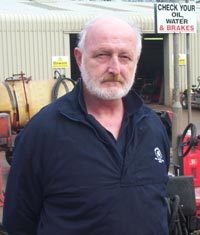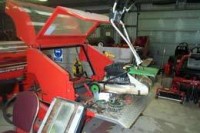So you want to buy a grinder?
So you want to buy a grinder?

A simple costing exercise is needed to clarify things for the people who sign the cheques for capital expenditure. Start with: -
1. Count the number of cylinders held and include everything, trim, fairway, pedestrian, ride on, redundant gangs used occasionally to hack down rough areas, leave nothing out to get your own way.
2. Calculate the length in inches.
3. Multiply by £2.00. This gives the cost (approx) to grind everything once. (But check your local people for prices and price structures; use the most expensive one in your exercise).
4. Check your records for past costs and break them down into elements such as bearings, seals, blades, and screws. Compare these to the prices you could have paid using after market spares. Mark this down as a saving in your exercise.
|
Quantity |
Machine |
Number of Units |
Length in inches |
Total inches |
|
2 |
Greens Triples |
6 |
21 |
126 |
|
4 |
Pedestrian Greens Mowers |
4 |
21 |
84 |
|
2 |
Trim Mowers |
6 |
30 |
180 |
|
2 |
Tees Triples |
6 |
30 |
180 |
|
2 |
Fairway Mowers |
10 |
21 |
210 |
|
2 |
Pedestrian Tees Mowers |
2 |
26 |
52 |
|
34 |
832 |
Cost to grind 34 units once @ £2.00 per inch = £1664.00
| Cost to grind 4 Greens Pedestrian Mowers 6 more times "in season" | £1008.00 |
| Cost to grind 2 Greens Triples 6 more times "in season" | £1512.00 |
| Cost to grind 2 Fairway Mowers 2 more times "in season" | £840.00 |
| Cost to grind 2 Pedestrian Tees Mowers 6 times "in season" | £624.00 |
| Cost to grind 2 Trim Mowers 2 more times "in season" | £720.00 |
If nothing is damaged by hitting objects with blades and no other grinding is done this would have cost £6368.00 if people will still do the job for £2.00 per inch. When doing your own costing you may find the price is well up from there.
A modest grinding set-up would be paid for in less than 3 years not counting the savings mentioned on spares.
Talking to grinder manufacturers representatives will point out further savings concerning the quality of cut, the plant healing process being accelerated, less fertiliser needed because of this, less mowing because there is no accelerated growth caused by the healing, process less disease because the plant is not so vulnerable, less irrigating because roots are stronger and longer and the plant being more drought tolerant etc. etc.
The wear and tear on machinery is less because the set is much lighter therefore the loads imposed on engines and drivelines is considerably less, the machine uses less fuel and lasts longer, belts last longer. These are all points that need mentioning when putting forward your case.
We have three mechanics here at The Celtic Manor Resort and I'm very lucky in that they are all very good mechanics that aren't afraid to get stuck in, eager to learn, easy to get along with, very cooperative and multi skilled. With the Ryder Cup only 5 years away there is a great deal of change going on, the expansion of Wentwood Hills golf course, construction/conversion of a second maintenance complex, construction of a second club house and a second practice area, the list isn't endless but its pretty long. All of this means expansion for the workshop, as extra machines and equipment will be needed as well as (possibly) splitting the workforce. This, unfortunately, doesn't make you more efficient, it tends to make you less efficient, there will be much travelling between the two service areas for spares, help etc. at least until we get more organised and the job gets sorted.
Machinery design has improved greatly in the last decade, for the most part manufacturers have responded to industry and legislative demands, (some have not and have paid a high price) machines in general are quieter, engines are quieter and many are situated behind the operator, since the human ear is designed to best pick up sound from the front and sides rather than from behind this has to be a vast improvement. An added bonus is the machine moves away from sound and leaves behind its noxious exhaust fumes.
Vibration levels have gone down with better seating; hydraulic drives to cutting cylinders and decks and multi piston diesel engines instead of single piston petrol. An aid to reduced vibration levels is "in house" grinding, this is done more frequently with the benefits mentioned earlier plus parallel cylinders and perfectly flat bed knives the whole unit is "in balance" and with the "set" being lighter the vibration is down.
Machinery design has some way to go though and I'm sure that legislation will help push it forward.
The Control of Substances Hazardous to Health states, "any kind of dust if its average concentration in the air exceeds the levels specified in COSHH e.g. 10mg/m3 for inhalable dust". This should include dust from machines on golf courses (particularly rough cutters) after all dust from machines used in industrial processes is included. Therefore cabs, filters and air-conditioning will become the norm rather than optional extras and they will have to be much improved, the type supplied today are adequate at keeping off the rain and some of the wind but that is all, except on a hot day they turn into a green house and the operator faints from heat exhaustion.
I think that is enough for now, I hope this is of some interest to somebody and perhaps food for thought, much of the content of these articles is old hat to many of you out there but perhaps not all of you!
